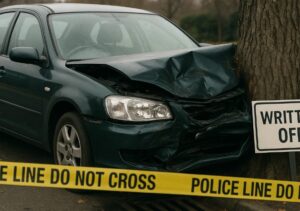More statistics relating to the use of ‘security-bypass’ or ‘keyless’ vehicle theft. The data appears to be from the 2022/23 Crime Survey for England and Wales. The accuracy of the data is therefore questionable. The Metropolitan Police (MPS), could not confirm the use of a jammer in 6 of 10 thefts (see below).
As for the use of the kit, the extent to which this is used can only be guessed at and, once again, there are mixed messages.

If a ‘jammer’ has no legitimate use it appears a person, not at their place of abode, who has with him any article (a jammer) for use in the course of or in connection with any theft* is guilty of s25 Theft Act 1968; ‘Going Equipped’ (see below).
s.25 was cited in 2023 – read more here.
*s25 extends to s12 – vehicle taking (TWoC).
A person guilty of an offence under this section shall on conviction on indictment be liable to imprisonment for a term not exceeding three years – time to make it 5 years?
If a ‘jammer’ has no legitimate use it appears a person, not at their place of abode who has with him any article (a jammer) for use in the course of or in connection with any theft* is guilty of s25 Theft Act 1968; ‘Going Equipped’ (see below).
*s25 extends to s12 – vehicle taking (TWoC).
It is reported (Telegraph):
- Car signal jammers that have contributed to a surge in luxury vehicle thefts
- The UK is to ban the sale and possession of electronic devices which can be used to jam remote locks.
- Signal jammers are now used in four in 10 car thefts nationwide and six in 10 in London
- the use of these electronic devices being so prolific
- new laws will prevent these devices from getting into the hands of thieves and organised crime groups.”
- Last year (2024), 132,412 cars were stolen across England and Wales, at a rate of 370 a day.
- Luxury brands including BMW, Land Rover and Mercedes-Benz are amongst the most targeted by thieves who typically operate in organised gangs.
- Relay theft and signal jamming is all too frequent
- Stolen cars are either shipped abroad or broken up for parts to be sold on the black market.
Does a Jammer have a Legit’ Use?
- ‘Currently, people can only be prosecuted if there is proof that they have used them to commit a crime’ (Independent)
Yet:
- ‘These devices have no legitimate purpose, apart from assisting in criminal activity …’ – Jenny Simms NPCC Vehicle Crime lead (BBC)
however ..
- ‘There are few legitimate uses for the devices ...’ (Telegraph)
and
- ‘Under the new rules, the burden of proof will be reversed – anyone caught with one will have to demonstrate they own it for justifiable reasons‘.
This is Money reported:
- ‘Anyone caught with a wireless jammer like this and is suspected of using it to steal vehicles could face up to five years in prison under the new laws‘ and
- ‘Currently, people can only be prosecuted if there is proof that they have used them to commit a crime‘
So there are ‘justifiable reasons’ for possession, they have a legitimate purpose? But:
- ‘possession, distribution or sale of the technology will be banned under new legislation’ (Independent)
and:
- ‘The legislation, which will make possession of signal jammers and relay devices an arrestable offense,’ (Thatcham)
The suggests there is no legitimate use … and no means to acquire the equipment (lawfully).
Theft From Vehicles
- More than 700,000 vehicles were broken into last year – often with the help of high-tech electronic devices (BBC)
- There were also a further 188,517 crimes last year which involved people’s possessions being stolen from their vehicle (Telegraph)
A discrepancy or, of the 700,000 vehicle broken into, possessions were only stolen in 188,517 cases i.e. the break-in led to no property removal in 511,483 (over half-a-million) cases? So what was the break-in (using electronic equipment) for, how did the victim know this had occurred and what crime was alleged & recorded?
s. 25 Theft Act 1968 –
Going equipped for stealing, etc.
A person shall be guilty of an offence if, when not at his place of abode, he has with him any article for use in the course of or in connection with any burglary or theft.
Where a person is charged with an offence under this section, proof that he had with him any article made or adapted for use in committing a burglary or theft shall be evidence that he had it with him for such use.
For purposes of this section an offence under section 12(1) of this Act of taking a conveyance shall be treated as theft




